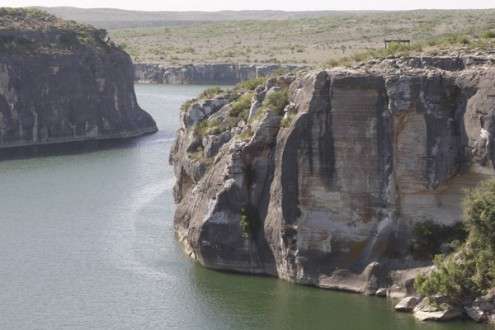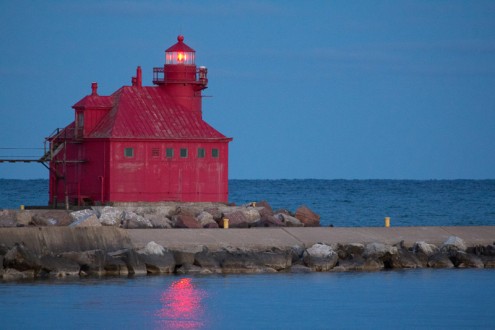
Compiling Bassmaster Magazine’s 100 Best Bass Lakes is a massive undertaking. The 2014 list is the third in this series, and the process of picking and ranking the lakes has become more involved each year.
James Hall, editor of Bassmaster Magazine, is in charge of the Top 100 project. He attacks it with a resolve that belies his laid-back demeanor.
“It took about three months to complete the list,” Hall said. “Nick Mason, an intern from Morehead State University, worked on it fulltime and did a lot of the groundwork.”
The first phase of that groundwork was to contact the fisheries division in every state’s wildlife agency. They were asked to provide whatever data they had on their best bass lakes, such as catch rates and electric shocking surveys.
They were also requested to include all lakes, not just popular bass tournament waters, and to rank the lakes based on these criteria:
- Quantity of Bass
- Quality of Bass
- Health of the Fishery
- Access
- Aesthetics (Scenery)
“The scenery at some lakes is so awesome that it makes for an incredible experience,” Hall said.
This data was put on a spreadsheet that provided a foundation for the Top 100 selections. The fisheries biologists were also asked how they would rank the best bass lakes in their state.
This information was then sent to every B.A.S.S. Nation President and Conservation Director to get their feedback. Some 560,000 Facebook fans were also polled for their top picks.
After this information was compiled, the list was cut to 180 lakes. It was then sent to the B.A.S.S. Council, a select group of 3,500 bass fanatics from across the nation. The country was divided into six regions. The Council members used the data from B.A.S.S. and their own experiences to rank the lakes in their region.
Further research included the results of bass tournaments, guide trips and input from Bassmaster’s Elite Series pros.
“Some of the most reliable feedback we got was from the Elite Series guys,” Hall said.
The Elite pros were especially helpful in ranking the lakes at the very top of the list. Since they’ve been to places like California’s Clear Lake, Florida’s Lake Okeechobee and Alabama’s Lake Guntersville, they can compare these great bass fisheries on a firsthand basis.
 Some lakes have risen or fallen considerably in the rankings based on the weather or other factors that have dramatically affected the fishing.
Some lakes have risen or fallen considerably in the rankings based on the weather or other factors that have dramatically affected the fishing.
“Amistad was in the Top 10 two years ago,” Hall said. “It fell completely off the Top 100 list this year because a drought has devastated the angler’s ability to catch fish.”
It has been taking extremely light weights to win tournaments at Amistad, and the low water has made boat access difficult.
“This year’s harsh winter froze out some lakes in Minnesota,” Hall said. “The oxygen level depleted and killed all the fish.”
Rising water levels at other lakes, such as Toledo Bend, have dramatically improved the fishing. When a reservoir has been down for a number of years and rises to cover what had been dry land it brings about what Hall calls, “the new lake effect.”
In past years, Bassmaster’s Top 100 picks would rank a Great Lake as a single entity. This time around, these inland seas have been broken down. For example, the many islands and offshore reefs in Lake Erie’s Western Basin don’t exist in the lake’s Eastern Basin near Buffalo.
This strategy allowed Lake Michigan’s Sturgeon Bay to claim the No. 1 spot on Bassmaster’s 100 Best Bass Lakes. It’s hard to argue with a fishery that is producing smallmouth bass of more than 8 pounds and five bass limits that exceed 30 pounds.
“It’s not practical for a guy to fish every area of a Great Lake from one boat ramp,” Hall said. “We’ve broken it down to a 30- to 40-mile radius from the most popular launch sites.”
With the two previous Top 100 lists, lakes of less than 3,000 acres were not included for fear of putting too much fishing pressure on them. The 2014 picks includes lakes under 3,000 acres.
“We decided that we were doing a disservice to areas of the country that had incredible small bass fisheries,” Hall said.
Another reason for including smaller lakes is to let B.A.S.S. members know that most of them have excellent bass fishing opportunities close to home.
“We want to get our members that don’t have a lot of time to travel a place where they can have a great day on the water,” Hall said.
See the photos of the 100 Best Bass Lakes of 2014 and find out which lakes were near-misses in “31 lakes that nearly made the Top 100.”

